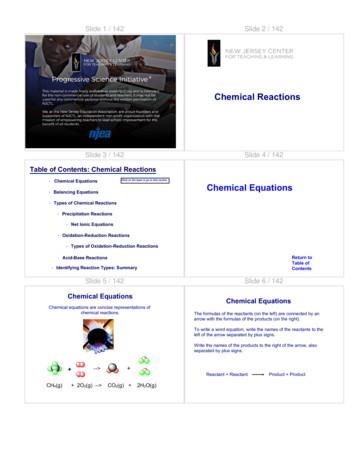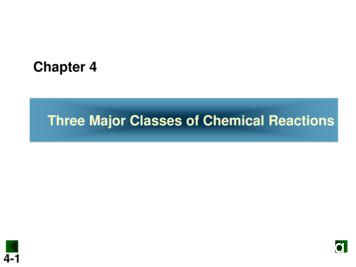Types Of Chemical Reactions Note - Ms. Keating's Web Site
Chemical Reactions
Types of Reactions There are five main types of chemicalreactions we will talk about:1.2.3.4.5. Synthesis reactionsDecomposition reactionsSingle displacement reactionsDouble displacement reactionsCombustion reactionsYou need to be able to identify the typeof reaction and predict the product(s)
Steps to Writing Reactions Some steps for doing reactions1.2.3.Identify the type of reactionPredict the product(s) using the type of reactionas a modelBalance itDon’t forget about the diatomic elements!(BrINClHOF) or (HOFBrINCl)For example, Oxygen is O2 as an element.In a compound, it can’t be a diatomic elementbecause it’s not an element anymore, it’s part ofa compound!
1. Synthesis reactions Synthesis reactions occur when two or moresubstances (generally elements) combine andform a compound. (Sometimes these arecalled combination or addition reactions.)reactant reactant 1 productBasically: A B AB Example: 2H2 O2 2H2OExample: C O2 CO2
Synthesis Reactions Here is another example of a synthesisreaction
Practice Predict the products. Write and balancethe following synthesis reaction equations.Sodium metal reacts with chlorine gasNa(s) Cl2(g) Solid Magnesium reacts with fluorine gasMg(s) F2(g) Aluminum metal reacts with fluorine gasAl(s) F2(g)
2. Decomposition Reactions Decomposition reactions occur when acompound breaks up into its elements orinto a few simpler compounds1 Reactant Product ProductIn general: AB A BExample: 2 H2O 2H2 O2Example: 2 HgO 2Hg O2
Decomposition Reactions Another view of a decomposition reaction:
Decomposition Exceptions Carbonates and chlorates are special casedecomposition reactions that do not go tothe elements. Carbonates (CO32-) decompose to carbondioxide and a metal oxide Chlorates (ClO3-) decompose to oxygen gasand a metal chloride Example: CaCO3 CO2 CaOExample: 2 Al(ClO3)3 2 AlCl3 9 O2There are other special cases, but we will notexplore those in Chemistry I
Practice Predict the products. Then, write andbalance the following decompositionreaction equations:Solid Lead (IV) oxide decomposesPbO2(s) Aluminum nitride decomposesAlN(s)
PracticeIdentify the type of reaction for each of thefollowing synthesis or decompositionreactions, and write the balanced equation:N2(g) O2(g) Nitrogen monoxideBaCO3(s) Co(s) S(s) (make Co be 3)NH3(g) H2CO3(aq) NI3(s)
3. Single Replacement/DisplacementReactions Single Replacement Reactions occur whenone element replaces another in a compound.A metal can replace a metal ( ) ORa nonmetal can replace a nonmetal (-).element compound compound elementA BC AC B (if A is a metal) ORA BC BA C (if A is a nonmetal)(remember the cation always goes first!)When H2O splits into ions, it splits intoH and OH- (not H and O-2 !!)
Single Replacement Reactions Another view:
Single Replacement ReactionsWrite and balance the following singlereplacement reaction equation: Zinc metal reacts with aqueoushydrochloric acidZn(s) 2 HCl(aq) ZnCl2 H2(g)Note: Zinc replaces the hydrogen ion in thereaction
Single Replacement Reactions Sodium chloride solid reacts with fluorine gas2 NaCl(s) F2(g) 2 NaF(s) Cl2(g)Note that fluorine replaces chlorine in the compound Aluminum metal reacts with aqueous copper(II) nitrateAl(s) Cu(NO3)2(aq)
4. Double Replacement Reactions Double Replacement Reactions occur whena metal replaces a metal in a compound and anonmetal replaces a nonmetal in a compoundCompound compound compound compoundAB CD AD CBNeutralization is a special type of doublereplacement that has an acid and a base as thereactants and a salt and water as the products.
Double Replacement Reactions Think about it like “foil”ing in algebra, first andlast ions go together inside ions go togetherExample:AgNO3(aq) NaCl(s) AgCl(s) NaNO3(aq)Another example:K2SO4(aq) Ba(NO3)2(aq) 2 KNO3(aq) BaSO4(s)
Practice Predict the products. Balance the equation5.HCl(aq) AgNO3(aq) CaCl2(aq) Na3PO4(aq) Pb(NO3)2(aq) BaCl2(aq) FeCl3(aq) NaOH(aq) H2SO4(aq) NaOH(aq) 6.KOH(aq) CuSO4(aq) 1.2.3.4.
5. Combustion Reactions Combustion reactionsoccur when a hydrocarbonreacts with oxygen gas.This is also calledburning!!! In order to burnsomething you need the 3things in the “firetriangle”:1) A Fuel (hydrocarbon)2) Oxygen to burn it with3) Something to ignite thereaction (spark)
Combustion Reactions The general equation for completecombustion:CxHy O2 CO2 H2OProducts in complete combustion areALWAYS carbon dioxide and waterbut in incomplete combustionthere are some by-products likecarbon and carbon monoxideCombustion is used to heat homesand run automobiles (which burnoctane, C8H18, a component ofgasoline)
Complete Combustion Example C5H12 8 O2 5 CO2 6 H2OWrite the products and balance thefollowing complete combustion reaction: C10H22 O2
Mixed Practice 1.2.3.4.5.State the type, predict the products, andbalance the following reactions:BaCl2 H2SO4 C6H12 O2 Zn CuSO4 Cs Br2 FeCO3
Total Ionic Equations Once you write the molecular equation(synthesis, decomposition, etc.), you shouldcheck for reactants and products that aresoluble or insoluble.We usually assume the reaction is in waterWe can use a solubility table to tell us whatcompounds dissolve in water.If the compound is soluble (does dissolve inwater), then splits the compound into itscomponent ionsIf the compound is insoluble (does NOT dissolvein water), then it remains as a compound
Solubility Table
Solubilities Not on the Table! Gases only slightly dissolve in waterStrong acids and bases dissolve in water Hydrochloric, Hydrobromic, Hydroiodic, Nitric,Sulfuric, Perchloric AcidsGroup I hydroxides (should be on your chart anyway)Water slightly dissolves in water! (H and OH-)For the homework SrSO4 does NOT dissolve inwaterThere are other tables and rules that cover morecompounds than your table!
Total Ionic EquationsMolecular Equation:K2CrO4 Pb(NO3)2 PbCrO4 2 KNO3SolubleInsolubleSolubleSolubleTotal Ionic Equation:2 K CrO4 -2 Pb 2 2 NO3- PbCrO4 (s) 2 K 2 NO3-
Net Ionic EquationsThese are the same as total ionicequations, but you should cancel out ionsthat appear on BOTH sides of theequationTotal Ionic Equation:2 K CrO4 -2 Pb 2 2 NO3- PbCrO4 (s) 2 K 2 NO3Net Ionic Equation:CrO4 -2 Pb 2 PbCrO4 (s)
Net Ionic Equations Try this one! Write the molecular, total ionic, and netionic equations for this reaction: Silver nitrate reactswith Lead (II) Chloride in hot water.Molecular:Total Ionic:Net Ionic:
THE END
Types of Reactions There are five main types of chemical reactions we will talk about: 1. Synthesis reactions 2. Decomposition reactions 3. Single displacement reactions 4. Double displacement reactions 5. Comb
Chemical Reactions Slide 3 / 142 Table of Contents: Chemical Reactions · Balancing Equations Click on the topic to go to that section · Types of Chemical Reactions · Oxidation-Reduction Reactions · Chemical Equations · Net Ionic Equations · Types of Oxidation-Reduction Reactions · Acid-Base Reactions · Precipitation Reactions
Lesson Overview Chemical Reactions and Enzymes Chemical Reactions and Enzymes. Lesson Overview Chemical Reactions and Enzymes Chemical Reactions A chemical reaction is a process that changes , or transforms, one set of chemicals into another by changing the
Chemical reactions called _ reactions give off heat. 5. Other reactions called _ reactions absorb heat and cool the immediate environment. 6. True or False. During all chemical reactions, a chemical change takes place that produces new substances with properties different than those of the original substances. .
The Major Classes of Chemical Reactions. 4.6 Elements in Redox Reactions 4.1 The Role of Water as a Solvent 4.2 Writing Equations for Aqueous Ionic Reactions 4.3 Precipitation Reactions 4.4 Acid -Base Reactions. 4.5 Oxidation -Reduction (Redox) Reactions 4.7
Special Topic 6.1: Oxidizing Agents and Aging 6.2 Oxidation Numbers Internet: Balancing Redox Reactions 6.3 Types of Chemical Reactions Combination Reactions Decomposition Reactions Combustion Reactions Special Topic 6.2: Air Pollution and Catalytic Converters Single-Displacement Reactions Internet: Single-Displacement Reaction 6.4 Voltaic Cells
ii. acid–base neutralization reactions iii. oxidation–reduction or redox reactions. Q.3. What are the important aspects of redox reactions? Ans: Almost every element participate in redox reactions. The important aspects of redox reactions are as follows: i. Large number of natural, biological and industrial processes involve redox reactions .
Dr. Solomon Derese 2 Reactions of organic compounds can be organized broadly in two ways by: I. What types of reactions and II. How these reactions occur. A chemical reaction is the transformation of one chemical or collection of chemicals into another chemical or collection of chemicals. A chemical reaction involves making new chemical
Astrology: The alignment of the planets and stars was very important, looking at when the patient was born and fell ill to decide what was wrong with them! This became more popular after the Black Death (1348) Astrology is a SUPERNATURAL explanation for disease. Apothecaries mixed ingredients to make ointments and medicines for the physicians. They learned from other apothecaries. They also .






















